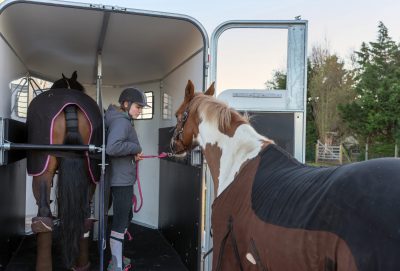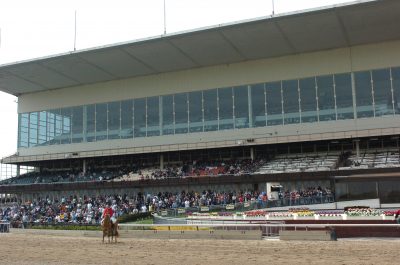By Ray Wallin
Winter is here.

Cold Weather Shipper- Photo courtesy of Equus Magazine
I don’t care what the calendar says, it arrives on Dec. 21. I gauge winter’s arrival by when I take the soft top off my Jeep and put the hard top back on, which coincidentally always aligns with the running of the Fair Grounds meet.
This year was no different. On a frigid day in November, I swapped the top and could barely feel my fingers when I was done. My friend Bob was laughing all the way from Florida where he’ll be making his living playing the ponies live from Gulfstream Park during their championship meet until we thaw out up here in New Jersey in April.
While many of the classier horses have shipped to warmer places or are taking the winter off, my attention shifts to those warmer climates for the “hard top” months. One interesting angle I like to play is when the horses conditioning down in the warmer regions ship back north to the less tepid conditions.
Horses are cold weather animals. They run their best when they are not subject to hot, muggy conditions. Wise trainers know to keep the horses in the hot, muggy conditions better hydrated than normal. I am sure you have pondered at some point what those horses that shipped up to Aqueduct from Florida seem to be better in some cases? It isn’t necessarily that they are better, it is that they are fresher with the cooler weather.
Not every horse that ships north in the cooler spring months is going to be a winner, otherwise everyone would be crushing this angle. Yet there are

Aqueduct Racetrack – Photo courtesy of Nyra.com
a few factors to look for that tip off when you can expect a big effort as the north starts to thaw in the March through May timeframe.
Drop in class or same class
Horses shipping north to the cooler temperatures still need to be spotted correctly. If a horse is making a big jump up the class ladder, he isn’t likely to win anywhere. We are looking for horses that are making slight moves or staying at the same level they have been running at. When you look at them on paper, if even a slight increase in form gives them an edge, then they are a contender.
You are also looking to make sure they aren’t taking a huge drop either. If an allowance horse ships to Aqueduct or Belmont and is running for $50,000 that is one thing, but if the same horse is instead running for $10,000 he is a toss. The trainer would have never shipped him north to lose him that fast. In this case he is looking to unload him to cover expenses.
Recent effort
When horses ship north, they need to have a recent race in their past performances. I prefer to see a race in the last 60 days, but not in the last couple of weeks. If they were on the shelf any longer, they would need to be raced back into form, any shorter they may not be recovered from the drive north or acclimated to the new surroundings.
Workouts
Since we aren’t looking for horses with a very recent start, we do need to look for some activity that kept them sharp. A workout or two after their last start is a positive sign, especially if they have at least one effort over today’s surface after shipping in.
This is a sign of form, even if it was a light breeze, it indicates that the horse is being kept fresh for this spot.
Like the distance
Horses are creatures of habit. They like what they like, especially the older they get. A horse that has had success at today’s distance is almost a given when you get to horses that are five years old and up. With the differences at of the distances run at various tracks, we only ask for at least one finish at this distance where they hit the board.
A win at the distance is a bonus, but if a horse has cashed a check at a distance like 6 1/2 furlongs or a mile and 70 yards in the past, it is a positive factor that they will like it again here.
Like the track
Not only do some horses have a preferred distance, some have a track at which they do their best. You could call them a “horse for the course” but horses excel at a specific surface for several reasons. In the case of our northern shippers, they are likely making a move that they have made for several years. They spend the winter in Florida and ship back to New York like clockwork. Chances are that their trainers have them on the same work pattern or path back to the races as what has worked in the past.
Same trainer
When a horse ships north and keeps their warm weather trainer, this is a good sign. The trainer didn’t drop him for a fire sale to try to get him claimed in the last start, which means he was either properly placed or even a step above the right class. This also shows the trainer’s intent of getting a horse in shape to ship back north by either racing him back into form or working him back off a layoff.
The only time I back a horse that is shipping north off a claim is when the trainer has a previous history with the horse. He could be a claim back from another trainer or a change to or from an assistant to the main trainer.
Same jockey
When a horse ships north along with a trainer and the jockey that are regulars at the meet, this is a bonus. While this doesn’t happen too often, it is a big positive factor.
If the jockey has a history or riding this horse, then he won’t be learning what they can do while he is running, he already knows what the horse is capable of. When the jockey is a leading or top tier rider at the northern meet, it is helps to make the case to back them in this spot. The jockey could opt off and take a better mount, but if he stays the course and rides again in this spot, it is a good signal.
While we can’t all be snowbirds like many racehorses, we can take advantage of watching them ship in to the right spots. By looking for some factors which tip off what the horse is capable of or the trainer’s intent you can find some value when the betting public overlooks the potential improvement.

Ray Wallin is a licensed civil engineer and part-time handicapper who has had a presence on the Web since 2000 for various sports and horse racing websites and through his personal blog. Introduced to the sport over the course of a misspent teenage summer at Monmouth Park by his Uncle Dutch, a professional gambler, he quickly fell in love with racing and has been handicapping for over 25 years.
Ray’s background in engineering, along with his meticulous nature and fascination with numbers, parlay into his ability to analyze data; keep records; notice emerging trends; and find new handicapping angles and figures. While specializing in thoroughbred racing, Ray also handicaps harness racing, Quarter Horse racing, baseball, football, hockey, and has been rumored to have calculated the speed and pace ratings on two squirrels running through his backyard.
Ray likes focusing on pace and angle plays while finding the middle ground between the art and science of handicapping. When he is not crunching numbers, Ray enjoys spending time with his family, cheering on his alma mater (Rutgers University), fishing, and playing golf.
Ray’s blog, which focuses on his quest to make it to the NHC Finals while trying to improve his handicapping abilities can be found at www.jerseycapper.blogspot.com Ray can also be found on Twitter (@rayw76) and can be reached via email at [email protected].


